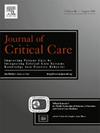右美托咪定对脓毒性休克患者临床和治疗结果的影响:随机试验的系统回顾和荟萃分析。
IF 2.9
3区 医学
Q2 CRITICAL CARE MEDICINE
引用次数: 0
摘要
背景:感染性休克是一种严重的健康问题,导致大量的发病率和死亡率。据报道,右美托咪定(DEX)可显著减轻脓毒性休克患者的血管加压药耐药性,提高临床疗效。我们的目的是研究DEX对感染性休克患者死亡率、临床和治疗结果的影响。方法:系统回顾和荟萃分析,综合来自PubMed, CENTRAL, Scopus和Web of Science的随机对照试验(rct)的证据,截至2025年1月,无语言限制。使用Stata MP v. 17,固定效应模型分别使用相对风险(RR)和平均差异(MD)报告二分类结果和连续结果,置信区间(CI)为95%。普洛斯彼罗id: CRD42025641437。结果:纳入8项随机对照试验,662例患者。DEX与常规护理在住院死亡率的主要结局方面无显著差异(RR: 0.78, 95% CI [0.56, 1.11], p = 0.17)。同样,ICU死亡率的次要结局(RR: 0.73, 95% CI [0.48, 1.13], p = 0.16)和长期死亡率(RR: 0.90, 95% CI [0.73, 1.11], p = 0.33)无显著差异。两组在ICU住院时间(LOS) (MD: 0.07, 95% CI [-0.97, 1.12], p = 0.89)、机械通气时间(MD: 0.29, 95% CI [-0.26, 0.84], p = 0.30)和血管加压剂输注时间(MD: -0.32, 95% CI [-0.79, 0.15], p = 0.18)方面无显著差异。然而,DEX显著增加了医院LOS (MD: 1.12, 95% CI [0.19, 2.04], p = 0.02)。结论:在证据确定性较低的情况下,DEX对死亡率、ICU LOS、机械通气时间、血管加压剂输注时间、急性肾损伤、心动过缓、低血压和谵妄无显著影响。然而,DEX显著增加了医院的LOS。本文章由计算机程序翻译,如有差异,请以英文原文为准。
The effect of dexmedetomidine on clinical and management outcomes in patients with septic shock: A systematic review and meta-analysis of randomized trials
Background
Septic shock constitutes a significant health concern, resulting in substantial morbidity and mortality. Dexmedetomidine (DEX) was reported to significantly mitigate vasopressor resistance in septic shock, enhancing clinical outcomes. We aim to investigate DEX effect on mortality, clinical, and management outcomes in septic shock patients.
Methods
Systematic review and meta-analysis synthesizing evidence from randomized controlled trials (RCTs) obtained from PubMed, CENTRAL, Scopus, and Web of Science until January 2025 without language restrictions. Using Stata MP v. 17, fixed-effects model used to report dichotomous outcomes and continuous outcomes using relative risk (RR) and mean difference (MD), respectively, with a 95 % confidence interval (CI). PROSPERO ID: CRD42025641437.
Results
Eight RCTs and 662 patients were included. There was no significant difference between DEX and usual care for the primary outcome of in-hospital mortality (RR: 0.78, 95 % CI [0.56, 1.11], p = 0.17). Similarly, no significant differences were found for secondary outcomes of ICU mortality (RR: 0.73, 95 % CI [0.48, 1.13], p = 0.16), and long-term mortality (RR: 0.90, 95 % CI [0.73, 1.11], p = 0.33). No significant difference between both groups regarding the ICU length of stay (LOS) (MD: 0.07, 95 % CI [−0.97, 1.12], p = 0.89), mechanical ventilation duration (MD: 0.29, 95 % CI [−0.26, 0.84], p = 0.30), and vasopressor infusion duration (MD: -0.32, 95 % CI [−0.79, 0.15], p = 0.18). However, DEX significantly increased hospital LOS (MD: 1.12, 95 % CI [0.19, 2.04], p = 0.02).
Conclusion
With low certainty of evidence, DEX did not significantly impact mortality, ICU LOS, mechanical ventilation duration, vasopressor infusion duration, acute kidney injury, bradycardia, hypotension, and delirium. Still, DEX significantly increased hospital LOS.
求助全文
通过发布文献求助,成功后即可免费获取论文全文。
去求助
来源期刊

Journal of critical care
医学-危重病医学
CiteScore
8.60
自引率
2.70%
发文量
237
审稿时长
23 days
期刊介绍:
The Journal of Critical Care, the official publication of the World Federation of Societies of Intensive and Critical Care Medicine (WFSICCM), is a leading international, peer-reviewed journal providing original research, review articles, tutorials, and invited articles for physicians and allied health professionals involved in treating the critically ill. The Journal aims to improve patient care by furthering understanding of health systems research and its integration into clinical practice.
The Journal will include articles which discuss:
All aspects of health services research in critical care
System based practice in anesthesiology, perioperative and critical care medicine
The interface between anesthesiology, critical care medicine and pain
Integrating intraoperative management in preparation for postoperative critical care management and recovery
Optimizing patient management, i.e., exploring the interface between evidence-based principles or clinical insight into management and care of complex patients
The team approach in the OR and ICU
System-based research
Medical ethics
Technology in medicine
Seminars discussing current, state of the art, and sometimes controversial topics in anesthesiology, critical care medicine, and professional education
Residency Education.
 求助内容:
求助内容: 应助结果提醒方式:
应助结果提醒方式:


